In today’s digital world, it is all about being widely accessible to users. Therefore, websites play a huge role in providing companies the chance to engage and sell their products and services. As a result, website architecture hugely matters the way we build a website in 2024.
Nowadays, it is not just the face of the website that matters. Also, the constituents of a website are very important. For example, the technology, programming language, tools, and platform are vital for a website development project undertaking.
As we proceed through 2024, companies are looking for ways to further their business globally and in the United States. By integrating the concept of the perfect website architecture, you are giving yourself a definite edge. This empowers you with higher visibility, product growth, and better marketing capabilities.
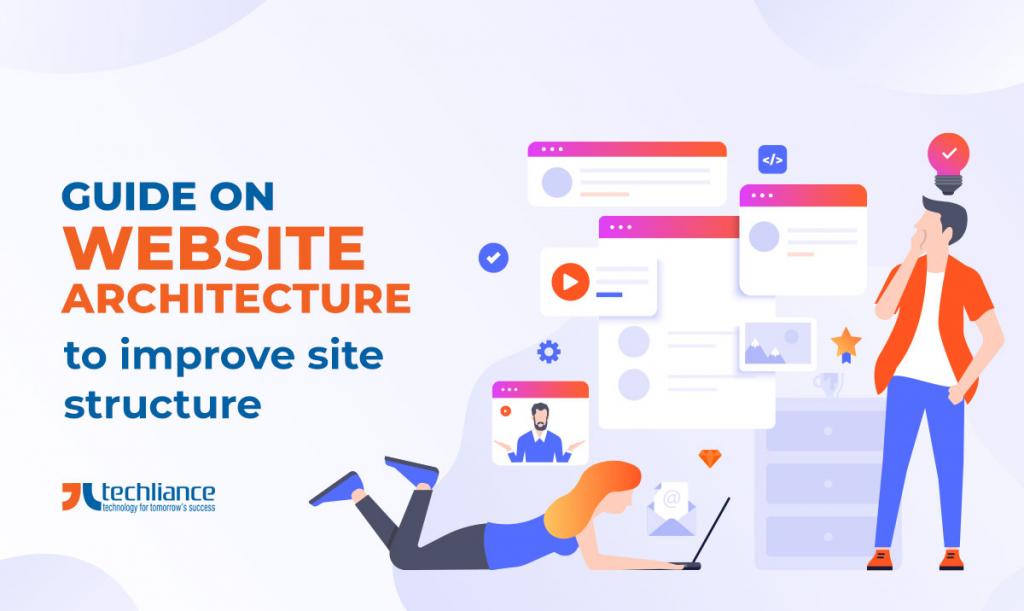
What is website architecture?
Delving further, we now define the website structure that is the foundation for the entire website.
The website architecture is the whole layout, and structure that organizes and delivers the content on your website. It includes the hierarchy of pages that helps users in finding content. Also, website structure incorporates the technical considerations that let search engine bots crawl your pages.
Today, website architecture matters as it helps define everything that ultimately the website will be built on. Because websites are not pages full of endless content just for the sake of having an online presence. They are your agents for getting user attention, retaining users, showcasing products, and enabling sales for greater revenue generation.
This implies that websites need to be properly thought out before execution. Many questions begin to surface as soon as the product website idea is floated around to the stakeholders. Here are some of these queries that need answers for making a functional website architecture.
- What will be the website design?
- How would the website layout be?
- What is the website document structure going to be?
- How are we going to manage SEO on the website?
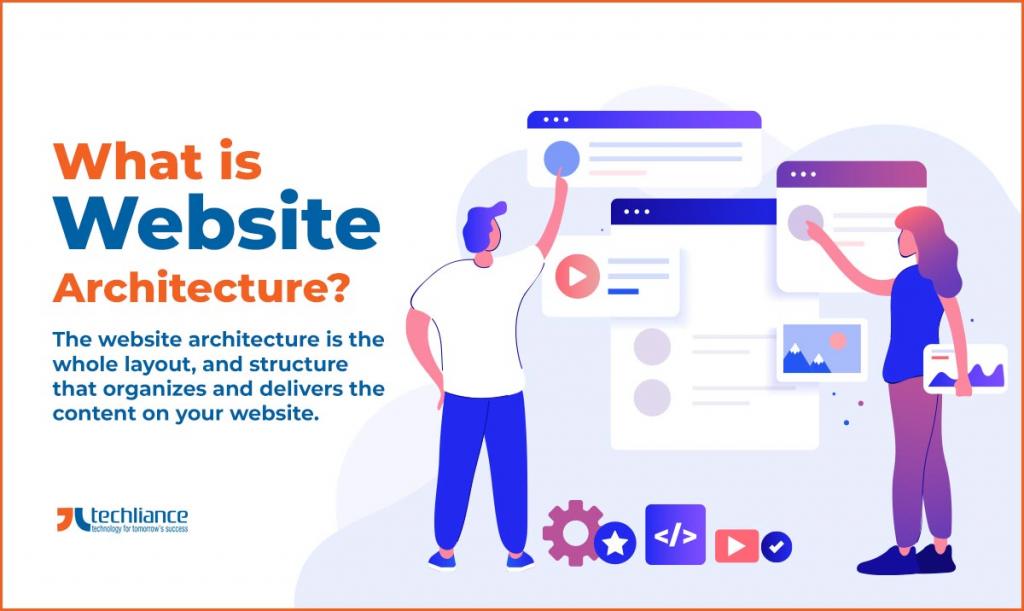
User-centric websites take better jumps than that are not
First impressions matter, and there’s no greater example than a website to demonstrate this. The type or appearance of a company’s website significantly impacts a customer’s perception of it. Presently, customers need to trust a brand.
Thus, having a website is decisive today. We anticipate things to appear so that we may make an impression on them as social and naturally superficial beings. If you want to succeed in today’s market, businesses must be innovative enough to stand out.
A company’s website is an essential tool for demonstrating its value to clients. After all, a website distinguishes you from your competitors in today’s competitive digital market. A real well-functioning website that makes life easy for you and your consumers is necessary for a strong online presence.
Businesses can reach out to customers not only locally but also internationally using a website. In the event, your website is interesting enough for customers to explore. Then, there is a good chance they’ll recommend it to others looking for a similar service.
Always keep in mind that a well-designed, user-friendly website will assist you in generating more leads. Any company’s goal is to provide the greatest possible service to its clients. When it comes down to it, the customers’ first engagement with a brand occurs through its digital presence (a website). Ensure that consumers can browse and discover what they’re searching for, by making a website as user-centric as possible.
Main types of website architecture
These are the core kinds of website structure worldwide.
- Hierarchical Model
- Sequential Model
- Matrix Model
- Database Model
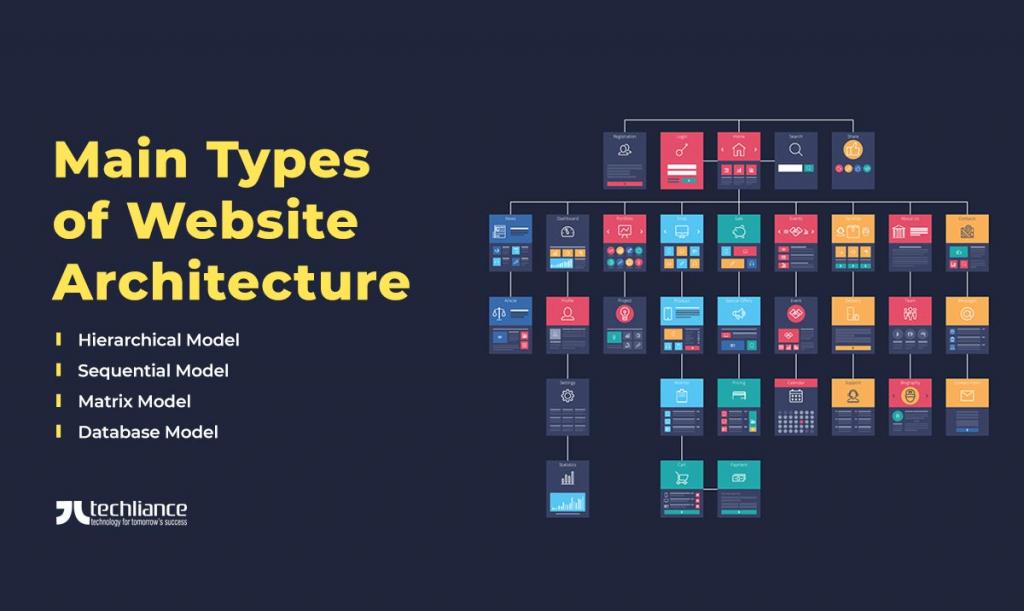
Now, we narrate some of the chief types of website architecture in this section to further our discussion.
Hierarchical Model
The hierarchical model is one of the most common types of website architecture. It is often used in web applications that contain a large amount of data. Just like a tree, the hierarchical model has a trunk (homepage) that branches out into categories and pages. Websites like CNN and BBC are great examples of the hierarchical model.
Sequential Model
You can use the sequential model to develop flows for a process. The sequential model is popular when leading users through a sequence like onboarding or new account creation. Here, you take the user through the process step-by-step.
Accordingly, UX designers can utilize this model to create flows for a process. This model is ideal for today’s process-driven web projects. Individual pages on wikiHow are strong examples of pages designed with sequences in mind.
Matrix Model
The matrix model of website architecture lets users choose where they want to go next. It is one of the oldest site structure types on the internet. This model is unique and non-traditional in its behavior.
A matrix-type structure gives users options to choose where they want to go next. These types of websites are best navigated via search or internal links. Wikipedia is a perfect example of the matrix model.
Database Model
The database model of a web structure determines the logical structure of a data-driven website. Thus, the database model is a dynamic approach to the website structure. To build a website structure like this, designers should think about the bottom-up approach.
They must consider the metadata of a web page. Likewise, they should adhere to strong information architecture and taxonomic best practices. Medium.com and its posts and pages are a good example of a database model.
Critical elements of website architecture to implement
The days of companies designing typical HTML websites are over. Gone are the days when customers come to a website only for what they need as a service. Today with every click and with every step, customers expect awesomeness from a brand.
Even though it sounds extravagant, customers always want to come back to a website for something new. This pushes businesses to explore new design trends for websites. The aim is to make sure the customers don’t bounce from websites until completing their final activities.
Here are some different components of website architecture that companies can experiment with throughout 2024.
- Faster the better
- Simple, modern, and minimalist
- Dynamic and mobile responsive
- The power of storytelling
- Innovative scroll navigation
- Web accessibility for everyone
- Right copywriting to fetch good conversions
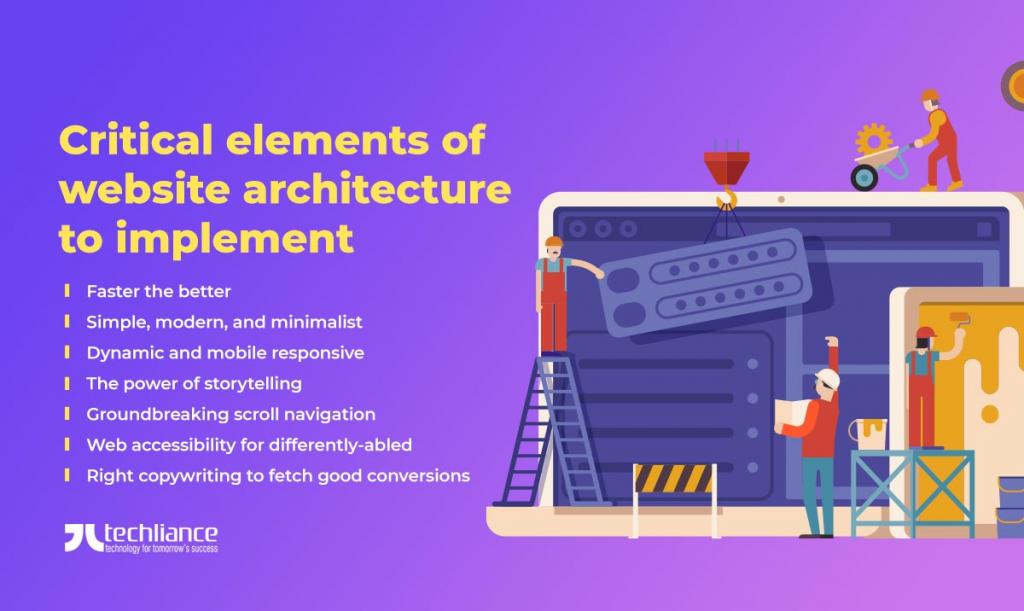
Let’s have a look at these factors for website architecture in detail.
Faster the better
Page speed is how quickly your website loads when someone opens it in a browser. Quicker the website, the finer the user experience. Not all customers have the time to wait for a slow webpage to load.
As a very first thing, ensure to adequately optimize your website elements. A webpage should take no more than three seconds to load at a maximum. A good website has a page load speed of below 2 seconds (up to 1.7 seconds or less).
Optimize web pages by compressing images and enhancing other elements of websites. This is one of the best ways to improve your webpage speed. Ideally, try to get less than 1 second page load time for ensuring fast websites.
Simple, modern, and minimalist
Clutter is terrible, and millennials want websites that are basic and minimalistic. Currently, users have less focus on quantity and prefer quality more. Simple minimalist websites are not only appealing to the eye but are also user-friendly.
They provide a simplified experience that many people prefer. These days, less is more, and modern minimalistic websites are turning increasingly popular in the web design field. Many people discover how much nicer these websites are. As they want clear and attractive websites that direct them to their favorite activities on the page.
Dynamic and mobile responsive
The ability to respond to mobile devices is critical. Customers no longer have to wait to arrive at a location to learn about a brand. Also, they don’t have to use their laptops or PCs to get info about a product or service.
At present, information is always at the users’ fingertips in today’s environment thanks to smartphones. As a result, businesses have to remain accessible and available to their customers from anywhere and everywhere. So, your website must adjust to any device they use, especially mobile phones and tablets.
The power of storytelling
Let your brand story inspire others. Show your customers not just your products but also the story of your brand. Count on the impact of storytelling to tell your customers what your brand exactly is. Sharing brand stories through storytelling is in trend for a while, and many brands are doing it.
The first step to storytelling is understanding your audience. They can be customers, investors, clients, partners, or anyone else. Design your website to simplify the brand while giving out a powerful message to the audience.
Realize that visuals are 90% of the information that human minds process. HP research finds people remember 80% (what they see and do), 20% (what they read), and 10% (what they hear). That’s why more and more businesses are using visual content on websites and marketing campaigns.
Groundbreaking scroll navigation
Traditional scrolling on websites has become outdated now. The web designs of today demand something more unique and interesting. Properly integrating scroll navigation builds interest and excitement among users.
There have come some new rules for scroll designs that you should know. Incorporate stories through your scroll. While click is always the bait, story scrolling will help you add more flare to your website. It’s time to break the myth of yesteryears that users don’t like scrolling web pages.
Users never mind doing it as long as it is interesting enough to make them stay on the page. The boat is a great example of scroll navigation amazingly telling the story on the website. Scrolling can have many types: horizontal scrolling, vertical scrolling, long scrolling, fixed long scrolling, infinite scrolling, and parallax scrolling.
Web accessibility for everyone
Deliver the same experience to all users with web accessibility, regardless of their age or impairment. This is why must handle this component of web design for a website to rank highly. Bear in mind that one of the most significant aspects of website accessibility is providing alt text.
Many designers believe that focusing on user accessibility has no significant influence. Although, this belief is not accurate in any way. You never know who your website’s senior or junior users are.
An inclusive website is not only desirable but also beneficial in terms of search engine rankings. This web design aspect is timeless, both now and in the future. So, make your website accessible for everybody.
Right copywriting to fetch good conversions
One thing that many businesses and designers miss out on while designing websites is the stimulus of website copywriting. One powerful website copy weighs more than a design that you may create. The content you put on your website defines your brand and your business.
Website copies (onsite content) also improve your SEO. Speaking of consumers, many consumers remember a brand by its tagline or the copy it represents. Similarly, it is great to build a strong relationship between your brand and your customers.
Trailblazing ideas to diversify website architecture
Here are some innovations that can make a whole big difference in website architecture within 2024.
- Illustrations are the new normal
- Easily accessible chatbots
- Puzzle, scavenger hunt, and spin wheel
- Rotating VR animations
- Videos for visually appealing websites
- Scroll-triggered animations
- Lively typography is a win-win
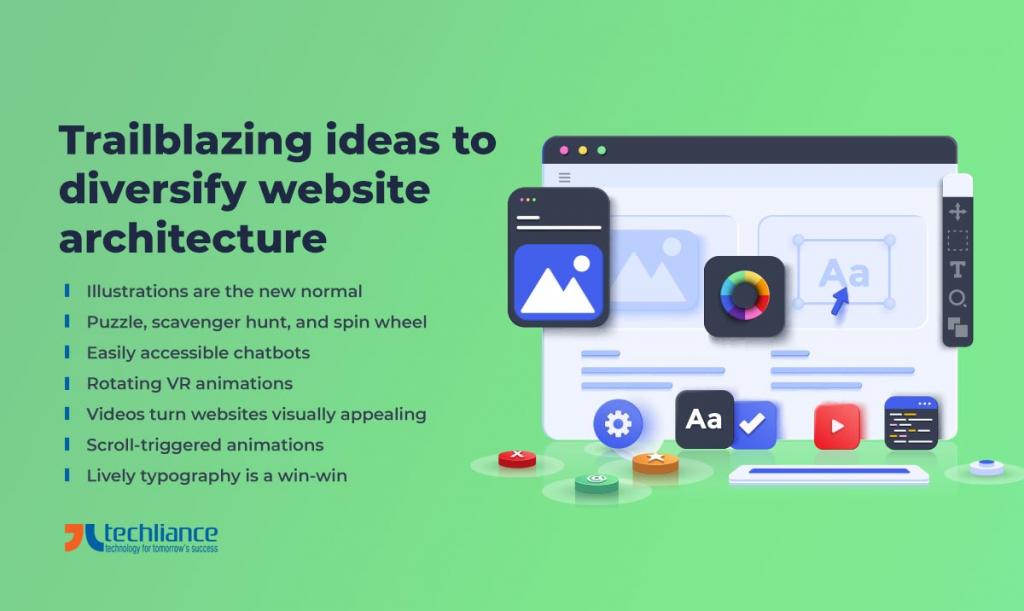
Next, we have a peek over these revolutionary concepts for website architecture briefly.
Illustrations are the new normal
To not look too basic, you first have to incorporate extraordinary things into your website. One way to replace the elementary graphic design on your website is with illustrations. Use illustrations to deliver powerful messages to your customers.
This design concept is turning out very popular now and will remain so in the future. One major reason to adopt this trending web design is that illustrations load much faster than high-definition photography. Google’s page experience update (and Core Web Vitals) motivates designers to acclimatize to methods that improve website speed.
Puzzle, scavenger hunt, and spin wheel
The reward for going all creative is getting new customers. In web design, customers love it when the website is creative enough to intrigue them the very first time. Daisy-chaining the website and converting the web pages into puzzles is a great option to make things interesting for users.
Creating the web page like a puzzle for the visitors to solve turns it thought-provoking for users. You can use this design to spur things up during a product reveal, or a video launch. Also, you can put on spin a wheel for anything else relating to brand exposure, contests, and giveaways.
Marketing Agency ThreeSixtyEight made a fun scavenger hunt for its employees to find the new location of their company’s retreat. A creative cursor, music in the background, and a suspense theme were all a part of this design idea. This concept was excellently executed and unearthed curiosity among the staff.
Easily accessible chatbots
Like it or hate it, automation is the future, and customers love it when help is just a click away. One of the most important web design elements to consider amid 2024 and beyond is the incorporation of chatbots.
Advance-level chatbots that are easy to use are customers’ favorite. They simplify the whole experience of users’ association with a brand. Another reason why a brand’s website needs a real-time chat feature is that it converts visitors to customers.
Speedily responding to users with accurate answers is one of the reasons for this. Providing necessary help quickly by identifying keywords is a great way to build customers’ trust in the brand. Giving the chatbot a cool avatar impresses customers and makes the experience pretty interesting.
Tip: Incorporate AI to automate chat responses to up your game in customer support.
Rotating VR animations
From boxy buttons to parallax scrolling, web design has come a long way. Virtual reality (VR) is one such website design experience that is now popular. VR transports visitors to an alternate virtual world that is unlike anything they’ve ever seen formerly.
The extra conversions will almost certainly come from your WebVR experience. You are delivering a virtual experience to your clients by incorporating VR. You can give your business a greater touch and vision with virtual reality.
For instance, a real estate company can employ VR to display customers a 360-degree image of their home. You can use virtual reality to enable both the product and the brand. Also, can go next-level and traverse the metaverse thanks to VR.
Videos to turn websites visually appealing
Embedding videos on the website homepage (or landing pages) is one of the most significant web design styles of 2024. The fascinating website of the Y.CO yacht company is a good example. This homepage will make you want to go on a cruise even if you haven’t done so before.
An interactive cursor is a good inclusion on the webpage. The website focuses on presenting its selling point most appealingly and distinctively. Also, this design enhances the brand’s initial impression.
Another simple yet elegant video embedded website homepage is of Solein. The website shows how versatile its innovator Solar Foods is in producing protein from the air rather than soil. Correspondingly, the video demonstrates how you can use Solein protein in everyday meals and food products.
Scroll-triggered animations
Right now, cursors have gone out of style. Visitors these days prefer the current scrolling alternative. Instead of popping out a box, takes them on a journey with each scroll or click.
Animations that trigger on scroll don’t affect initial page load time. This creates a one-of-a-kind user experience and boosts engagement. So, it can play a crucial role for startups, small businesses, and enterprises.
Customers want to know where the website takes them without the typical mouse pointer. Animations actively grab the users’ attention and increase traction. Also, it ensures that as many people see the product story as possible.
Lively typography is a win-win
Playing with words is nothing new for a brand. At the same time, powerful website copies are important. Additionally, how you make them stand out as a designer is even more vital.
Using chunky fonts and playful typography will emerge as the next big thing from 2024. It is always fresh, bold, and is graphic enough to capture anyone’s attention. Simultaneously, don’t use too many font styles, as it can get messy.
Top benefits of website architecture
How can this concept help your website? Just consider UI/UX design process and how its elements empower your website. A great web design is a blueprint, the crux, and the basis of your entire website.
Having website architecture in place, together with aiding the design, you’re also helping the entire web development process that follows. When the entire schema is properly planned out, it gives leverage for all resources to proactively work together. Thus, they can understand and identify what needs to be planned and how it can be managed.
Let’s round up on some major advantages of website architecture for 2024 and future years.
- Greater Grip on Project Scope
- Minimal Content Gaps
- Holistic Product Visibility
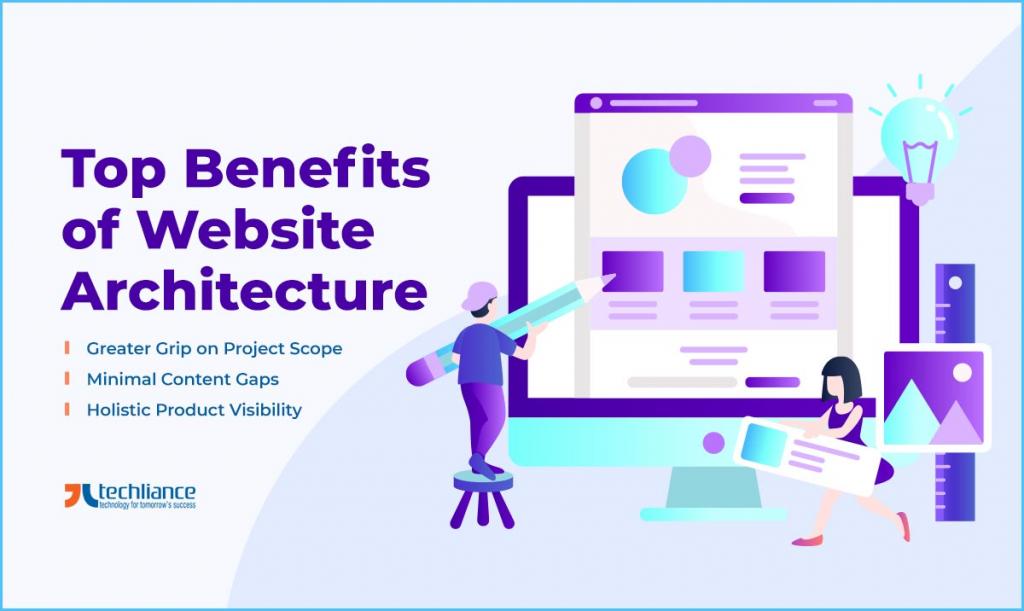
Lastly, we further our discussion by looking at these benefits of website structure.
Greater Grip on Project Scope
A website layout is not just a visual aid for designers. Also, it’s not either just for the customer to understand what the website will look like. This is a lot more as it helps to map interaction patterns and paths.
Each business use case is constructed to give out the outcome of how the user will interact with the system. Consequently, it provides great visibility of what the system looks like. Moreover, you get to know what needs to be done to make it happen.
This way, it also helps in finalizing and locking the scope. It is a great achievement for projects where not knowing the scope brings uncertainty and potential risks. Consider, limited budget and stringent project deadlines.
If you only have the general know-how of what needs to be done. But the how part is yet to be figured out. Then, you will certainly go through many challenges to achieve what is required.
A website structure helps you craft it all out. So that the client, project manager, and all stakeholders have a very distinct idea of what needs to be accomplished. Having a finalized scope can be a great thing for minimizing and mitigating risks.
This helps in the great manageability of project resources within the given timeframe and budget. Furthermore, it helps to understand the hierarchy, number of layers, and the web development services required for completing the website. In a nutshell, it’s great visibility and manageability of tasks.
Minimal Content Gaps
Realize that website information architecture is all about the organization of the information including the content. As the developers work on their specific tasks, they can logically interpret content to identify the content requirements. So, you can overcome the content gaps through various processes.
For instance, content groupings, decision-congestion, intuitive control, unused areas, recursive paths, or duplication. This will also separate the necessary content from the superfluous information. It is especially necessary for an existing website with lots of content.
Holistic Product Visibility
With complete marketing automation, you can carry out many marketing initiatives such as blogs and landing pages. In today’s world, everything is about users and fulfilling their needs. In this regard, SEO plays a huge role in how your website does on the internet.
You want to make sure your business gets all the necessary boost during 2024. The website architecture is all about this as it helps in mapping interaction paths. Whether you are a well-known business or a startup, you look for a proper holistic view of the product.
Hence, website structure is your best friend for a strong standing in the market. You want to create a product that not works but also connects with its audience. So, this concept can help you achieve that and future-proof your business growth.

Conclusion
Some clear rewards of website architecture can help you engage and connect with your audience. Also, when we talk about product roadmap, the websites with the right information structure take the edge. As they can continue working towards enhancing user experience by building on the existing blueprint.
In case, you want to get started on the right standing for a website undertaking. Then, it is best to work logically in the correct direction. This further eases your technical growth and business progress.
Do you want to create that seamless website for your business to help boost your company growth? Join hands with Techliance today to start your upscaling journey. We have got you covered for long-lasting success in the online world.




